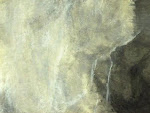How to draw Ink Painting: 4: Sesshū
☆
Buddhist painter Sesshū (雪舟 | せっしゅう, 1420-1506) and his
《View of Ama-no-Hashidate》(天橋立図 | あまのはしだてず) (c. 1502–1505), Kyoto National Museum. Image by Wikipedia Commons .
☆
Brief history: "Japanese Art Thesaurus Database: Painting" has his school and yearly commentary
☆
Footprints of journeys as a monk painter:
Bicchū Akahama(備中国赤濱) , present place name is Sōja-city, Okayama-pref (岡山県総社市) Hōfukuji-temple (宝福寺) (1430. He was about 10 years)→
Kyoto, Shōkokuji-temple(京〔相国寺〕) (about 13 to 32 years old) →
{Kumogaya, Miyanomura, Suō}(周防,宮根村雲ケ谷) (Yamaguchi-pref | 山口県) →
“Unkoku-an” (雲谷庵) (about 1454) →
Ming (China)(1467-69), {Ningbo}(寧波), “Jungfu temple”(天童山景福寺) in {Siming Difan}(四明地方) →
{Beijing}(北京) →
Return Japan, {Bungo} (Ōita-pref.) (豊後|大分県), {Buzen}(Fukuoka pref.)(豊前 | 福岡県) (about 1473) →
{Iwami}(Shimane-pref.) (岩見, 島根県)(about 1479)→
{SuŌ}(周防)(1480)→
{Mino}(Gifu pref.)(美濃, 岐阜県)(1481)→
{Kantō region}(関東地方) →
{SuŌ}(周防)(about 1483)→
{Amanohashidate}(Kyōto)(京都,天橋立)(1501)→ {Iwami}
(岩見) (Died in 1506)
Kyoto, Shōkokuji-temple(京〔相国寺〕) (about 13 to 32 years old) →
{Kumogaya, Miyanomura, Suō}(周防,宮根村雲ケ谷) (Yamaguchi-pref | 山口県) →
“Unkoku-an” (雲谷庵) (about 1454) →
Ming (China)(1467-69), {Ningbo}(寧波), “Jungfu temple”(天童山景福寺) in {Siming Difan}(四明地方) →
{Beijing}(北京) →
Return Japan, {Bungo} (Ōita-pref.) (豊後|大分県), {Buzen}(Fukuoka pref.)(豊前 | 福岡県) (about 1473) →
{Iwami}(Shimane-pref.) (岩見, 島根県)(about 1479)→
{SuŌ}(周防)(1480)→
{Mino}(Gifu pref.)(美濃, 岐阜県)(1481)→
{Kantō region}(関東地方) →
{SuŌ}(周防)(about 1483)→
{Amanohashidate}(Kyōto)(京都,天橋立)(1501)→ {Iwami}
(岩見) (Died in 1506)
☆
He studied painting as a disciple of "Shūbun"(周文). His pen name was "Sessō Tōyō"(拙宗等揚), probably because of the painting school of "Josets"(如拙).
He was in a low position of "Shika" (知客|しか) who served guests at Zen temple. Because he was a master of painting, he was accompanied by “Envoy to Ming (China)”.
He studied painting in "Ming China" with "Chang Yousheng"(長有声) and "Li Zai"(李在). Also the scenery of China was his master.
He studied painting in "Ming China" with "Chang Yousheng"(長有声) and "Li Zai"(李在). Also the scenery of China was his master.
(Reference; Yakuchū Honchō Gashi (訳註本朝画史) / ed. by Kasai, Masaaki (笠井, 昌昭). Vol. 4, p.30
Sketches:
- 《Tangtu Shengjing Tuguan》(唐土勝景図巻) by Reproduction of "Sesshū" school painter.
- 《Chinda falls》(鎮田の滝)(Yamaguchi pref. 山口県) copied by Kanō, Tsunenobu (狩野常信).
- 《Amanohashidate》(in Kyōto 天橋立, 京都) (National Treasure) after 82 years old.
He copied China's masterpieces and improved his painting skills. After that, he sketched a lot of actual scenery and was also selected as "the world's 10 largest cultural people" at the "World Peace Council" held in 1956. 。
☆
"Translation and commentary: Honchōgashi" by Masaaki Sakurai has texts from the Edo period, translations into modern languages, and detailed notes. You read it and get knowledge.
"Translation and commentary: Honchōgashi" by Masaaki Sakurai has texts from the Edo period, translations into modern languages, and detailed notes. You read it and get knowledge.
☆
Let's investigate "Sesshū" in "Wikipedia" and "Kotobank" and Hasumi, Shigeyasu(蓮見, 重康)(1960) , etc.
Let's investigate "Sesshū" in "Wikipedia" and "Kotobank" and Hasumi, Shigeyasu(蓮見, 重康)(1960) , etc.
Commentary:《Amanohashidate-zu》(天橋立図). Ink on Japanese Paper. Sketch with paper added (draft book) The color of "temple" is red.
It is a bird's-eye view looking down at "Amanohashidate" from the top of the mountain.
Chion-ji Temple (Kurito Monju)(知恩寺,切戸の文殊) in the figure was built in 1501.
Nariaiji temple(成相寺) burned to 1507. Thus, this sketch was drawn during 1501-1507.
☆
Let's write what you felt.
Let's write what you felt.
☆
In addition to "Yakuchu Honcho Gashi" ed. By Masaaki Kasai, let's acquire more detailed knowledge by Hiroshi Kanazawa (1968), Susumu Hayashi (1993) and others
In addition to "Yakuchu Honcho Gashi" ed. By Masaaki Kasai, let's acquire more detailed knowledge by Hiroshi Kanazawa (1968), Susumu Hayashi (1993) and others
Another masterpieces: 《Splashed-ink Landscape scroll 破墨山水図 | はぼくさんすいず》
Self-compliment, and such as GetsuoShukyo (月翁周鏡), 1495 ←自賛・〔月翁周鏡〕等賛,1495年
Ink on a Japanese Paper, (Tokyo National Museum)
Commentary: A work when 76 years old. A painting made by throwing ink.
In self-compliment wrote as “gave a Haboku Shansui-zu(破墨山水図) to Sōen(宗淵)”.
Painting style integrating “rock wrinkles of Xiao Qui” and “abbreviated style by Liang Kai”.
Painting style integrating “rock wrinkles of Xiao Qui” and “abbreviated style by Liang Kai”.
This is vertically oriented mountains and abstracted painting style.
-------------------------
画僧〔雪舟〕(1420-1506)と《天橋立図》(Wikipedia Commons)
生涯:☆「日本美術シソーラス・データベース絵画編」 に流派と年譜的解説があります。
☆旅の画僧としての足跡:
備中国赤濱(現岡山県総社市)〔宝福寺〕(1430年十歳頃) →
京〔相国寺〕 (13才頃-32才) →
{周防国宮野村雲ガ谷} →
〔雲谷庵〕(1454年頃) →
明(1467-69){寧波}、{四明地方}の〔天童山景福寺〕→{北京}→
帰国{豊後}{豊前}(1473年頃)→{岩見}(1479年頃)→ {周防}(1480年)→ {美濃}(1481年)→
{関東地方}→
{周防} (1483年頃)→
{天橋立}(1501年)→
{岩見国}1506年没。
☆
備中国赤濱(現岡山県総社市)〔宝福寺〕(1430年十歳頃) →
京〔相国寺〕 (13才頃-32才) →
{周防国宮野村雲ガ谷} →
〔雲谷庵〕(1454年頃) →
明(1467-69){寧波}、{四明地方}の〔天童山景福寺〕→{北京}→
帰国{豊後}{豊前}(1473年頃)→{岩見}(1479年頃)→ {周防}(1480年)→ {美濃}(1481年)→
{関東地方}→
{周防} (1483年頃)→
{天橋立}(1501年)→
{岩見国}1506年没。
☆
〔周文〕 の弟子として絵を学び、〔如拙〕の絵を慕い〔拙宗等揚〕と画号与えられました。
【知客】(しか)という僧侶では低い地位でしたが、画事で遣明使に随行しました。
【明】では〔長有声〕、〔李在〕に学び、また実景を師匠としました(〔笠井, 昌昭〕編『訳註本朝画史. 巻四』 p.30に『本朝画史』)。
例:〔雪舟派〕摸《唐土勝景図巻》。
国内では{大分}の〔狩野常信〕摸《鎮田の滝》、{山口}の《山水長巻》などがあり、さらに、82才以降に{京・天橋立}をスケッチするなど、模本で画技を得た上で実景を凝視し画面に昇華した人生と言えます。
【知客】(しか)という僧侶では低い地位でしたが、画事で遣明使に随行しました。
【明】では〔長有声〕、〔李在〕に学び、また実景を師匠としました(〔笠井, 昌昭〕編『訳註本朝画史. 巻四』 p.30に『本朝画史』)。
例:〔雪舟派〕摸《唐土勝景図巻》。
国内では{大分}の〔狩野常信〕摸《鎮田の滝》、{山口}の《山水長巻》などがあり、さらに、82才以降に{京・天橋立}をスケッチするなど、模本で画技を得た上で実景を凝視し画面に昇華した人生と言えます。
☆
前述の〔笠井, 昌昭〕編『訳註本朝画史. 巻四』には原文、現代語訳、注があり、知識を得ましょう。
前述の〔笠井, 昌昭〕編『訳註本朝画史. 巻四』には原文、現代語訳、注があり、知識を得ましょう。
☆
ウィキペディア〔雪舟〕、コトバンク〔雪舟〕で調べましょう。〔蓮見, 重康〕(1960) も調べましょう
ウィキペディア〔雪舟〕、コトバンク〔雪舟〕で調べましょう。〔蓮見, 重康〕(1960) も調べましょう
☆
作品解説:《天橋立図》紙本墨画、紙を継ぎ足したスケッチ(稿本) 水墨に寺の一部朱筆。
天橋立を山の上から見下ろした鳥瞰図(ちょうかんず)です。
図中の〔知恩寺〕(切戸の文殊)は明応十年(1501)に建立、〔成相寺〕は永正四年(1507)で炎上しています。
両寺が描かれている1501-07年の間です。
天橋立を山の上から見下ろした鳥瞰図(ちょうかんず)です。
図中の〔知恩寺〕(切戸の文殊)は明応十年(1501)に建立、〔成相寺〕は永正四年(1507)で炎上しています。
両寺が描かれている1501-07年の間です。
☆
みなさん、どう感じたか、文章にしてみましょう。
みなさん、どう感じたか、文章にしてみましょう。
☆
前述の〔笠井, 昌昭〕編『訳註本朝画史. 巻四』、〔金澤弘〕(1968)、〔林進〕(1993) 等で、より詳しい知識を獲得しましょう。
前述の〔笠井, 昌昭〕編『訳註本朝画史. 巻四』、〔金澤弘〕(1968)、〔林進〕(1993) 等で、より詳しい知識を獲得しましょう。
----------------------------------------






